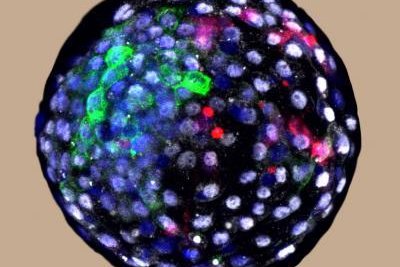A closeup image shows a chimera human-monkey blastocyst, a proto-embryo tissue mass.
Photo by Weizhi Ji/Kunming University of Science and Technology
April 15 (UPI) -- After injecting human stem cells into primate embryos, scientists were able to grow and maintain human-monkey chimeric embryos for up to 20 days.
The international research team, including geneticists in China and the United States, detailed their breakthrough in a new paper, published Thursday in the journal Cell.
Scientists suggest human-monkey chimeric embryos can be used to build models for studying human biology and disease.
"As we are unable to conduct certain types of experiments in humans, it is essential that we have better models to more accurately study and understand human biology and disease," senior study author Juan Carlos Izpisua Belmonte, an expert in pluripotent stem cells who operates a lab at the Salk Institute for Biological Studies in California, said in a news release. "An important goal of experimental biology is the development of model systems that allow for the study of human diseases under in vivo conditions."
The research builds on previous successes achieved by Izpisua Belmonte and his research partners in China. The team first successfully created human-monkey chimeric embryos a few years ago, keeping them alive for only a few days.
For the most recent experiments, researchers injected monkey embryos with up to 25 extended pluripotent stem cells, stem cells with the potential to form both embryonic and extra-embryonic tissues.
After a day, scientists detected human cells in 132 embryos. After 10 days, 103 of the chimeric embryos were still growing. By Day 19, just three of chimeric embryos were still alive. Throughout the experiment, the viable chimeric embryos maintained large concentrations of human cells.
"Historically, the generation of human-animal chimeras has suffered from low efficiency and integration of human cells into the host species," Izpisua Belmonte said. "Generation of a chimera between human and non-human primate, a species more closely related to humans along the evolutionary timeline than all previously used species, will allow us to gain better insight into whether there are evolutionarily imposed barriers to chimera generation and if there are any means by which we can overcome them."
Scientists observed the formation of new and strengthened communication pathways between human and monkey cells as the chimeric embryos grew.
"Understanding which pathways are involved in chimeric cell communication will allow us to possibly enhance this communication and increase the efficiency of chimerism in a host species that's more evolutionarily distant to humans," Izpisua Belmonte said.
Moving forward, scientists plan to identify and study the interspecies communication pathways that are essential to the viability of chimeric embryos. Eventually, researchers hope to convert chimeric embryos into models for studying human biology and disease. In the future, chimeric embryos could also be used to grow transplantable cells, tissues or organs.
In an editorial accompanying the newly published paper, scientists said they built in safeguards to avoid ethical problems throughout their experiments. These include ethical consultations and reviews at the institutional level and with outside bioethicists.















